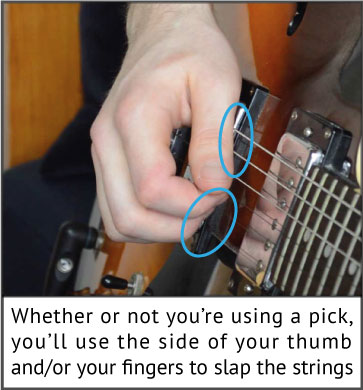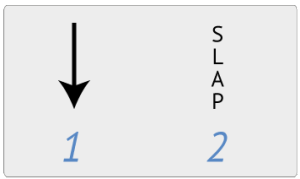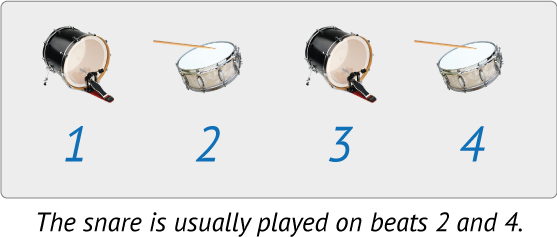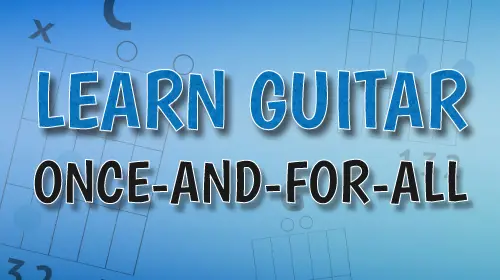In this lesson we’ll go over what is commonly referred to as the strum slap (… or “drumming on guitar,” “guitar percussion,” “slap strum,” “acoustic slap,” “percussive guitar technique,” or “percussive slap” – while googling the interweb, I discovered about 5 different names for this technique, so we’ll just keep it simple and call it a “slap” from here on!) It’s a great way to add another dimension to your strumming and after a while it’ll become so natural to your playing, you won’t even notice when you’re doing it – but you’ll be grooving harder than ever!
This technique can get pretty advanced as players like Tommy Emmanuel, Andy McKee and Michael Hedges, among others, have found some ingenious ways to emulate various percussion instruments by hitting their axe in very particular places, but it all starts with the simple strum slap.
The Basics – Getting A Good “Slap” Sound
The first thing you’ll want to do is try it. Don’t bother thinking too much, just lift your strumming hand and let it fall on the strings around the same place you’d strum them and see what happens. No matter what part of your hand you use, the sound comes from the same place: the strings are smacking against the highest frets of your guitar. You can aim for the lower strings, the higher strings or all of them.
Next, take a look at how your hand is making contact with the strings and judge for yourself if you like the sound you’re getting. Using the side of the thumb (twisting your forearm) to hit the strings against the neck is a good, easy way to get a pleasing smack out of your guitar since the side of the thumb is a bit harder. You can also add your fingernails to the mix by bending your fingers in, and making contact with the higher strings. All of this applies whether you are using a pick or not.

After you’ve decided how you want to hit the strings, try doing it really soft. THEN REALLY LOUD! And then somewhere in between. You’ll want to adjust your volume and intensity with each song you’re playing. Also take into consideration where you’re hitting the strings – near the soundhole, closer to the bridge, over the neck – you can get pretty darn creative here and if you take the time to experiment you’ll certainly discover some really neat sounds.

[fusion_soundcloud url=”https://soundcloud.com/goodguitarist/playalong-down-slap” layout=”visual” comments=”no” show_related=”no” show_user=”yes” auto_play=”no” color=”#ff7700″ width=”100%” height=”150px” class=”” id=””/]
Incorporating The Slap Into A Strumming Pattern
So you’ve taken the time and your strum slap is sounding great, but what about actually using it in a strumming pattern? It helps to understand a bit about how drums work (we’re doing a percussive technique, after all).
The strum slap sounds a lot like a snare drum. The snare is a set of metal wires that vibrate against the bottom of the snare drum, and we’re smacking a set of wires (guitar strings) against the neck of the guitar so it makes a similar sound. The drummer usually plays his or her snare on beats 2 and 4. Listen to the following example and hear it for yourself:

[fusion_soundcloud url=”https://soundcloud.com/goodguitarist/example-the-backbeat” layout=”visual” comments=”no” show_related=”no” show_user=”yes” auto_play=”no” color=”#ff7700″ width=”100%” height=”150px” class=”” id=””/]
So if the snare fits so nicely on beats 2 and 4, the strum slap definitely will too!
In the video I demonstrate this with a strumming pattern that you’d hear in a more up-tempo song, but for this article I’d like to start with a more relaxed pattern. Here’s what it sounds like without any strum slaps:

[fusion_soundcloud url=”https://soundcloud.com/goodguitarist/example-down-down-up-up-down” layout=”visual” comments=”no” show_related=”no” show_user=”yes” auto_play=”no” color=”#ff7700″ width=”100%” height=”150px” class=”” id=””/]
And if we replace beats 2 and 4 with slaps, this is what we end up with:

[fusion_soundcloud url=”https://soundcloud.com/goodguitarist/example-down-slap-up-up-slap” layout=”visual” comments=”no” show_related=”no” show_user=”yes” auto_play=”no” color=”#ff7700″ width=”100%” height=”150px” class=”” id=””/]
This example is great because we play an upstroke after a slap, and then an upstroke before the next slap – targeting most challenging aspect of incorporating the strum slap into a pattern.
- Slap + upstroke – When slapping the guitar, make sure your pick (or the tip of your thumb) is aiming towards the ground and lands under all the strings. This ensures your hand will be in position to perform an upstroke immediately.
- Upstroke + slap – It’s pretty straight-forward. After the upstroke your hand should be lifted above the strings and ready to fall. Let gravity do its thing.

[fusion_soundcloud url=”https://soundcloud.com/goodguitarist/playalong-down-slap-up-up-slap” layout=”visual” comments=”no” show_related=”no” show_user=”yes” auto_play=”no” color=”#ff7700″ width=”100%” height=”150px” class=”” id=””/]
Challenge: Learn to do a strum and a slap simultaneously to create a very powerful, rich percussive effect on your guitar.
First, perform a downstroke. Then, as your pick (or thumb/fingers) cross the lowest strings, rotate your wrist and smack the heel of your thumb down towards the strings. It takes a bit of getting used to, and you need to get the timing right to avoid getting notes out of the strings, – but you’ll be rewarded with a pleasing wood and metal sound that cuts through the mix.


[fusion_soundcloud url=”https://soundcloud.com/goodguitarist/playalong-up-tempo-slap-strum-exercise” layout=”visual” comments=”no” show_related=”no” show_user=”yes” auto_play=”no” color=”#ff7700″ width=”100%” height=”150px” class=”” id=””/]
Incorporating The Slap Into A Fingerpicking Pattern
If you’re already comfortable playing some fingerstyle, and you’ve worked through the above exercises, this should be a cinch. The most difficult part about incorporating the slap technique into fingerstyle is landing your fingers in the correct place so they can pluck the strings immediately after landing (when necessary).
Generally, when you play with your fingers, you assign each finger to a string (Thumb = 4, 5, 6. Index = 3, Middle = 2, Ring = 1). When you perform a slap, you need to lift your hand away from the guitar, so each of these fingers will have to find its place again. This is the challenge: getting each finger to land where it belongs so it can pluck that string immediately if needed. Aside from that, there isn’t much else to it.
The example below isn’t the most difficult fingerstyle pattern, but that’s not the point. What we’re trying to do is implant the timing in your brain so you naturally feel when to slap the guitar. Combine that with naturally landing your fingers in the correct spots and this technique will feel natural in no time! (Naturally!)

[fusion_soundcloud url=”https://soundcloud.com/goodguitarist/playalong-fingerstyle-slap” layout=”visual” comments=”no” show_related=”no” show_user=”yes” auto_play=”no” color=”#ff7700″ width=”100%” height=”150px” class=”” id=””/]
Some Tips For Applying This To Electric Guitar
The technique itself is exactly the same, the only difference comes from the fact that you are amplified. Particular amp settings are subjective and depend on so many different factors so here are some basic guidelines.
- Just like with an acoustic guitar, how you’re playing the slap is very important (probably the most important) so make sure it sounds and feels good before you turn up the volume knob
- The bass knob will make the biggest difference for slap volume and presence
- If the treble is too high you may get all these weird creaky, squeak noises, so be aware of that
- Compression will address all volume issues. If you have a really transparent compressor or one with a blend knob you can smooth out the volume difference between your slap and the notes you’re playing
Ultimately, it’s a balance. You need to make the slap sound good, but you don’t want to sacrifice your tone to do so. There are a million factors so take this advice with a grain of salt; these are just things I’ve found help me get the right sound when I’m playing and performing.
Bonus Exercise
I’m including one more pattern here, for those of you who want the extra practice (and because I think this pattern sounds so cool… especially when you add a couple of slaps to it). It’s pretty grungy and slow, which is great for learning the technique, and sounds great on an electric or acoustic guitar.

[fusion_soundcloud url=”https://soundcloud.com/goodguitarist/playalong-down-slap-up-down-down-slap” layout=”visual” comments=”no” show_related=”no” show_user=”yes” auto_play=”no” color=”#ff7700″ width=”100%” height=”150px” class=”” id=””/]
If you are really keen to adopt this technique, try experimenting with some strumming patterns (here’s a good starting point) and seeing where you can get this to fit. If you work through each of the above exercises and give them enough time, you’ll get the feel for it and incorporating this technique into new strumming patterns will happen easily and naturally.

Develop the fundamental skills needed to play guitar with confidence. Hands-on learning, presented in a clear and concise manner. Learn the basics using real songs, strum with a steady rhythm, master the basic chord shapes, learn to count along to music and more!
Click here